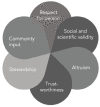A Community-Driven Framework to Prioritize the Use of Donated Human Biological Materials in the Context of HIV Cure-Related Research at the End of Life
- PMID: 37252012
- PMCID: PMC10225111
- DOI: 10.20411/pai.v8i1.583
A Community-Driven Framework to Prioritize the Use of Donated Human Biological Materials in the Context of HIV Cure-Related Research at the End of Life
Abstract
Initiated in 2017 after extensive community engagement, the Last Gift program enrolls altruistic volunteers willing to donate their cells and tissues at the end of life to allow studies on HIV reservoir dynamics across anatomical sites. As the Last Gift team received tissue requests outside the scope of HIV cure research, we noticed the absence of guiding frameworks to help prioritize the use of altruistically donated human biological materials. In this commentary, we present a proposed framework for prioritizing the use of donated human biological materials within and outside the end-of-life (EOL) HIV cure research context, using the Last Gift study as an example. First, we discuss regulatory and policy considerations, and highlight key ethical values to guide prioritization decisions. Second, we present our prioritization framework and share some of our experiences prioritizing requests for donated human biological materials within and outside EOL HIV cure research.
Keywords: End of life; HIV cure research; donations; ethics; human biological materials; immunity; pathogens; tissues; virology.
Copyright © Pathogens and Immunity 2021.
Conflict of interest statement
The authors declare no conflicts of interest.
Figures
Similar articles
-
Ethical and practical considerations for HIV cure-related research at the end-of-life: a qualitative interview and focus group study in the United States.BMC Med Ethics. 2022 Jan 11;23(1):2. doi: 10.1186/s12910-022-00741-8. BMC Med Ethics. 2022. PMID: 35012544 Free PMC article.
-
"My Death Will Not [Be] in Vain": Testimonials from Last Gift Rapid Research Autopsy Study Participants Living with HIV at the End of Life.AIDS Res Hum Retroviruses. 2020 Dec;36(12):1071-1082. doi: 10.1089/AID.2020.0020. Epub 2020 Jun 24. AIDS Res Hum Retroviruses. 2020. PMID: 32449625 Free PMC article.
-
People with HIV at the end-of-life and their next-of-kin/loved ones are willing to participate in interventional HIV cure-related research.AIDS. 2024 Feb 1;38(2):235-243. doi: 10.1097/QAD.0000000000003754. Epub 2023 Oct 17. AIDS. 2024. PMID: 37861674 Free PMC article.
-
Medical Assistance in Death as a Unique Opportunity to Advance Human Immunodeficiency Virus Cure Research.Clin Infect Dis. 2019 Aug 30;69(6):1063-1067. doi: 10.1093/cid/ciz068. Clin Infect Dis. 2019. PMID: 30715211 Review.
-
Applying the Behavioural and Social Sciences Research (BSSR) Functional Framework to HIV Cure Research.J Int AIDS Soc. 2019 Oct;22(10):e25404. doi: 10.1002/jia2.25404. J Int AIDS Soc. 2019. PMID: 31665568 Free PMC article. Review.
Cited by
-
"This Is How I Give Back": Long-Term Survivors on Legacy and HIV Cure Research at the End of Life-A Qualitative Inquiry in the United States.Infect Dis Rep. 2025 Jul 4;17(4):78. doi: 10.3390/idr17040078. Infect Dis Rep. 2025. PMID: 40700324 Free PMC article.
References
-
- Palella FJ, Jr., Delaney KM, Moorman AC, Loveless MO, Fuhrer J, Satten GA, Aschman DJ, Holmberg SD. Declining morbidity and mortality among patients with advanced human immunodeficiency virus infection. HIV Outpatient Study Investigators. N Engl J Med. 1998;338(13):853–60. doi: 10.1056/NEJM199803263381301. PubMed PMID: 9516219. - DOI - PubMed
-
- Goodkin K, Kompella S, Kendell SF. End-of-Life Care and Bereavement Issues in Human Immunodeficiency Virus-AIDS. Nurs Clin North Am. 2018;53(1):123–35. doi: 10.1016/j.cnur.2017.10.010. PubMed PMID: 29362056; PMCID: PMC5837059. - DOI - PMC - PubMed
-
- Perry KE, Dubé K, Concha-Garcia S, Patel H, Kaytes A, Taylor J, Javadi SS, Mathur K, Lo M, Brown B, Sauceda JA, Wohl DA, Little S, Hendrickx S, Rawlings SA, Smith DM, Gianella S. “My Death Will Not [Be] in Vain”: Testimonials from Last Gift Rapid Research Autopsy Study Participants Living with HIV at the End of Life. AIDS Res Hum Retroviruses. 2020;36(12):1071–82. Epub 2020June24. doi: 10.1089/AID.2020.0020. PubMed PMID: 32449625; PMCID: PMC7703253. - DOI - PMC - PubMed
-
- Gianella S, Taylor J, Brown TR, Kaytes A, Achim CL, Moore DJ, Little SJ, Ellis RJ, Smith DM. Can research at the end of life be a useful tool to advance HIV cure? AIDS. 2017;31(1):1–4. doi: 10.1097/QAD.0000000000001300. PubMed PMID: 27755112; PMCID: PMC5137789. - DOI - PMC - PubMed
Grants and funding
LinkOut - more resources
Full Text Sources
Research Materials


